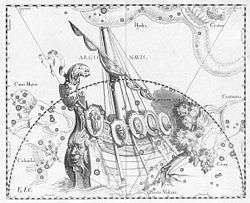Argo Navis

Argo Navis (the Ship Argo), or simply Argo, was a large constellation in the Earth's southern sky that has since been divided into three constellations. It represented the Argo, the ship used by Jason and the Argonauts in Greek mythology. The genitive was "Argus Navis", abbreviated "Arg". Flamsteed and other early modern astronomers called the constellation just Navis (the Ship), genitive "Navis", abbreviated "Nav".
Due to precession, the stars of Argo have been shifted farther south since Classical times, and far fewer of its stars are visible today from the latitude of the Mediterranean.[1]
The original constellation was found low near the southern horizon of the Mediterranean sky. The ship became visible in springtime and sailed westward, skimming along the southern horizon. The ancient Greeks identified it with the ship sailed by Jason and the Argonauts to Colchis in search of the Golden Fleece.[2]
Argo Navis is the only one of the 48 constellations listed by the 2nd century astronomer Ptolemy that is no longer officially recognized as a constellation. It was unwieldy due to its enormous size. In 1752, the French astronomer Nicolas Louis de Lacaille subdivided it into Carina (the keel, or the hull, of the ship), Puppis (the poop deck, or stern), and Vela (the sails). Lacaille replaced Bayer's designations with new ones that followed the stars' magnitudes more closely; but like Bayer, he used a single Greek-letter sequence for the three parts: Carina has α, β and ε, Vela has γ and δ, Puppis has ζ, and so on.[3]:82 (For the dimmer stars, however, Lacaille used a separate Latin-letter sequence for each part.)[3]:82 The duplication of omicron in Vela and Puppis appears to contradict this, but "omicron Puppis" is an error for Lacaille's o Puppis (Latin oh).[3]:85, 259
The constellation Pyxis (the mariner's compass) occupies an area which in antiquity was considered part of Argo's mast. Some authors state that Pyxis was part of the Greek conception of Argo Navis,[4][5][6] but magnetic compasses were unknown in ancient Greek times. Lacaille considered it a separate constellation, representing one of the modern scientific instruments he placed among the constellations (like Microscopium and Telescopium). In the notes to his preliminary catalogue, published in 1756, Lacaille wrote: “I have divided [Argo] into three parts, namely la Pouppe [Puppis], le Corps [Carina] & la Voilure [Vela]”.[7] Pyxis was listed separately, among his 14 new constellations. Lacaille assigned Bayer designations to Pyxis separate from those of Carina, Puppis and Vela, and his illustration shows an isolated instrument not related to the figure of Argo.[3]:262 In 1844 John Herschel suggested formalizing the mast as a new constellation, Malus, to replace Lacaille's Pyxis, but the idea did not catch on.[2]
The Māori had several names for what was the constellation Argo, including Te Waka-o-Tamarereti, Te Kohi-a-Autahi, and Te Kohi.[8]
See also
References
- ↑ "Pam Eastlick. University of Guam.".
- 1 2 Ian Ridpath. "Argo Navis". Star Tales. Retrieved 27 Jan 2015.
- 1 2 3 4 Morton Wagman, Lost Stars, McDonald and Woodward, 2003, ISBN 0-939923-78-5.
- ↑ John Scalzi (2008) Rough Guide to the Universe, p. 240 (ISBN 9781405383707)
- ↑ David H. Kelley, et al. (2011) Exploring Ancient Skies: A Survey of Ancient and Cultural Astronomy, p. 12 (9781441976246)
- ↑ Emily Winterburn (2009) The Stargazer's Guide, p. 124 (ISBN 9780061976377)
- ↑ Lacaille, N., Histoire de l'Académie royale des sciences, 1752 (published 1756), p. 590.
- ↑ Makemson, Maud Worcester (1941). The Morning Star Rises: an account of Polynesian astronomy. Yale University Press. p. 279.
External links
- Starry Night Photography : Argo Navis Image
- Star Tales – Argo Navis
- Warburg Institute Iconographic Database – Argo (Navis) (over 160 medieval and early modern images of Argo Navis)
| Wikimedia Commons has media related to Argo Navis. |